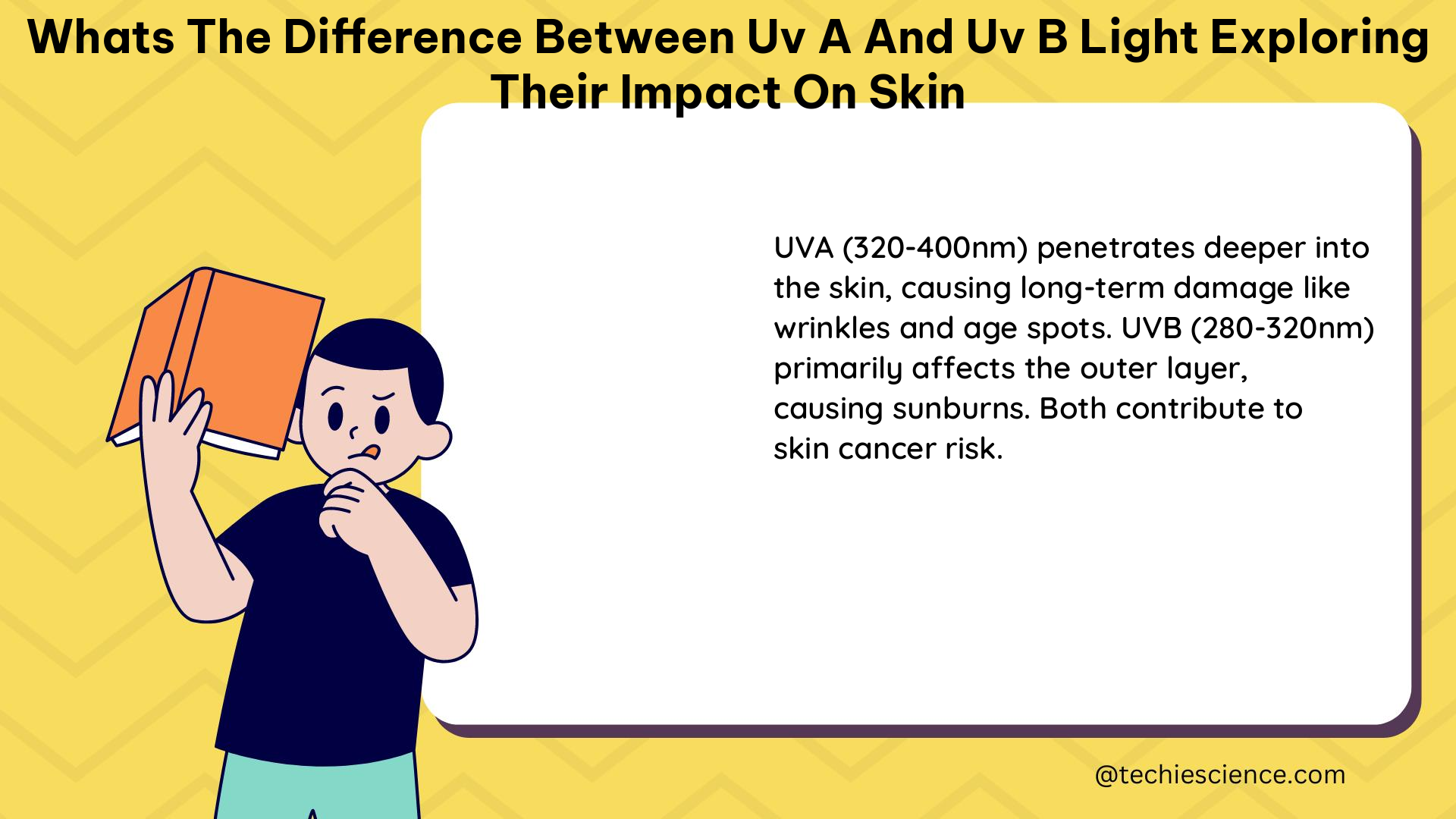UVA and UVB rays are two types of ultraviolet (UV) radiation that reach the earth’s surface from the sun. Understanding the differences between these two types of UV light and their impact on the skin is crucial for maintaining healthy skin and preventing long-term damage.
Energy Levels and Wavelengths
UV radiation is a form of electromagnetic energy, and its wavelengths are classified into three categories: UVA, UVB, and UVC. UVA rays have the longest wavelengths, ranging from 320 to 400 nanometers (nm), followed by UVB rays, which have wavelengths between 280 and 320 nm. UVC rays have the shortest wavelengths, ranging from 100 to 280 nm, but they are completely filtered out by the ozone layer and do not reach the earth’s surface.
In terms of energy levels, UVA rays have the lowest energy, with an average energy of around 3.1 eV (electron volts), while UVB rays have a higher energy level, with an average energy of around 4.4 eV. UVC rays have the highest energy level, with an average energy of around 6.2 eV, but as mentioned, they do not reach the earth’s surface.
The energy levels of UV radiation can be calculated using the formula:
E = h × c / λ
Where:
– E is the energy of the UV radiation (in eV)
– h is Planck’s constant (6.626 × 10^-34 J·s)
– c is the speed of light (3 × 10^8 m/s)
– λ is the wavelength of the UV radiation (in m)
Using this formula, we can calculate the energy levels of UVA, UVB, and UVC rays:
| UV Type | Wavelength Range (nm) | Energy Range (eV) |
|---|---|---|
| UVA | 320 – 400 | 3.1 – 3.9 |
| UVB | 280 – 320 | 3.9 – 4.4 |
| UVC | 100 – 280 | 4.4 – 12.4 |
Skin Cells Affected

UVA rays can penetrate the skin more deeply, reaching the dermis, the middle layer of the skin. This layer contains fibroblasts, which are responsible for producing collagen and elastin, the proteins that give skin its structure and elasticity. UVA exposure can damage these fibroblasts, leading to premature skin aging, wrinkles, and sagging.
On the other hand, UVB rays primarily affect the epidermis, the outermost layer of the skin. This layer contains keratinocytes, which are the most abundant skin cells. UVB exposure can damage these cells, leading to sunburns, inflammation, and an increased risk of skin cancer.
Short-term and Long-term Effects
UVA rays can cause immediate tanning and sometimes sunburn, but their effects are often more subtle and long-lasting. Exposure to UVA rays can lead to the formation of free radicals, which can damage DNA and contribute to the development of certain types of skin cancer, such as melanoma.
UVB rays, on the other hand, are the primary cause of sunburns. They can also contribute to skin aging and the development of other types of skin cancer, such as basal cell carcinoma and squamous cell carcinoma.
Sources and Percentage of Sun’s UV Rays
UVA rays make up about 95% of the UV radiation that reaches the earth’s surface, while UVB rays account for about 5%. Both types of rays can be found in sunlight and are emitted by tanning beds.
The relative proportion of UVA and UVB rays in sunlight can vary depending on factors such as time of day, season, latitude, and weather conditions. For example, during the midday hours and in the summer months, the proportion of UVB rays is higher, leading to a greater risk of sunburns.
Protection Measures
To protect the skin from the harmful effects of both UVA and UVB rays, it is essential to use broad-spectrum sunscreen with a high sun protection factor (SPF). Broad-spectrum sunscreens are designed to protect against both UVA and UVB rays.
In addition to using sunscreen, other protective measures include:
- Wearing protective clothing, such as long-sleeved shirts, pants, and hats
- Seeking shade during peak UV hours, typically between 10 AM and 4 PM
- Avoiding tanning beds and other artificial sources of UV radiation
It is also important to note that the effectiveness of sunscreen can be influenced by factors such as application thickness, reapplication frequency, and environmental conditions. Proper use of sunscreen is crucial for effective protection against UV radiation.
Conclusion
Understanding the differences between UVA and UVB rays, their energy levels, wavelengths, and their impact on the skin is essential for maintaining healthy skin and preventing long-term damage. By taking appropriate protective measures, individuals can reduce their risk of sunburns, premature skin aging, and skin cancer.
References:
- The Skin Cancer Foundation. (n.d.). UV Radiation – The Skin Cancer Foundation. Retrieved from https://www.skincancer.org/risk-factors/uv-radiation/
- Healthline. (2019, September 12). UVA vs. UVB Rays: What’s the Difference? Retrieved from https://www.healthline.com/health/skin/uva-vs-uvb
- WebMD. (2023, July 24). What’s the Difference Between UVA and UVB Rays? Retrieved from https://www.webmd.com/melanoma-skin-cancer/difference-between-uva-rays-and-uvb-rays
- American Academy of Dermatology Association. (n.d.). Sunscreen FAQs. Retrieved from https://www.aad.org/public/everyday-care/sun-protection/sunscreen-patients/sunscreen-faqs
- National Institutes of Health. (2021, June 24). Ultraviolet (UV) Radiation. Retrieved from https://www.cancer.gov/about-cancer/causes-prevention/risk/radiation/uv-radiation-fact-sheet

The lambdageeks.com Core SME Team is a group of experienced subject matter experts from diverse scientific and technical fields including Physics, Chemistry, Technology,Electronics & Electrical Engineering, Automotive, Mechanical Engineering. Our team collaborates to create high-quality, well-researched articles on a wide range of science and technology topics for the lambdageeks.com website.
All Our Senior SME are having more than 7 Years of experience in the respective fields . They are either Working Industry Professionals or assocaited With different Universities. Refer Our Authors Page to get to know About our Core SMEs.